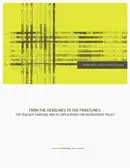This report suggests that even with the economic slowdown and the sense of relief from a pending teacher shortage, districts will continue to struggle to get and keep good teachers unless they make dramatic changes in the ways they recruit teachers.
Beginning in 1999, concern about the supply of teachers for the nation’s elementary and secondary schools found its way to the top of the education policy agenda. Warnings about a national teacher shortage loomed in the headlines, raising serious questions about whether or not schools and districts could fully staff their classrooms. But as the economy slowed in the fall of 2002, the sense of impending disaster appeared to subside. News reports gave the impression that there was nothing like a good recession to take care of the once ubiquitous teacher shortage.
Unfortunately, this overly tidy resolution encourages us to move on to the next big education issue (No Child Left Behind implementation, state budget problems) before understanding what the shortage problem was, and what its implications are for district human resource management. A more serious examination of the problem and the way districts responded to it suggests that, despite the fading concern, many districts will nevertheless continue to struggle to get and keep good teachers unless they make dramatic changes in the ways they recruit teachers.





